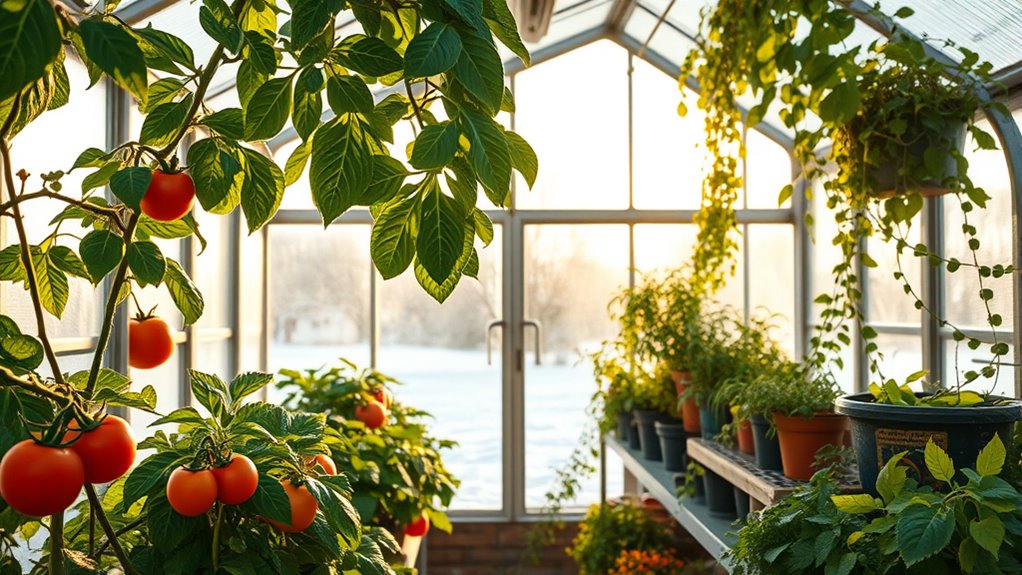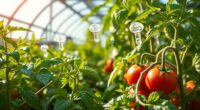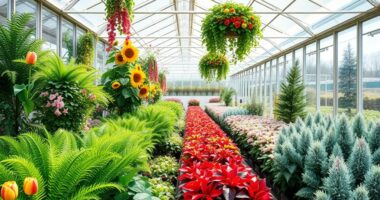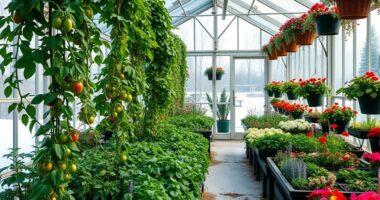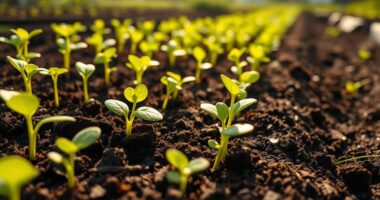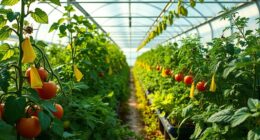To extend your growing season with a winter greenhouse, choose a durable, well-insulated structure with proper ventilation and climate control systems. Focus on growing hardy crops like kale, spinach, and herbs, and use supplemental heat sources such as thermal curtains and heating mats. Manage light and airflow carefully to prevent disease, and prepare nutrient-rich soil for year-round growth. Small adjustments can make a big difference—explore more tips to keep your winter gardening thriving.
Key Takeaways
- Use insulated, durable greenhouse designs with thermal curtains and thermal mass to retain heat during winter.
- Incorporate climate control systems, vents, and fans to regulate temperature and humidity levels effectively.
- Select hardy crops like kale, spinach, and herbs suited for low-light and cold conditions.
- Enhance soil with compost, organic fertilizers, and pH adjustments to support healthy winter plant growth.
- Maximize light exposure through strategic plant placement, reflective surfaces, and proper ventilation to prevent disease.
Choosing the Right Greenhouse for Winter Use

When selecting a greenhouse for winter gardening, you need to prioritize insulation and durability to withstand cold temperatures. A well-designed greenhouse ensures proper greenhouse ventilation, preventing excess humidity and maintaining consistent temperatures. Incorporating automation technologies such as automatic vents or climate control systems can further optimize environmental conditions. Look for a structure with sturdy framing materials like aluminum or galvanized steel that can endure harsh winter conditions. The greenhouse design should include features like vent openings, vents, or automatic windows to facilitate air circulation and temperature regulation. Consider a design that minimizes heat loss and promotes efficient airflow, which is vital for healthy plant growth during colder months. Additionally, researching reliable greenhouse suppliers can help ensure you select a structure that meets quality standards and offers long-term durability. By choosing a greenhouse with solid construction and thoughtful ventilation options, you’ll create a resilient environment that supports year-round gardening success.
Insulation and Heating Solutions for Cold Months

To keep your greenhouse warm during the coldest months, effective insulation and reliable heating solutions are essential. Start by installing thermal curtains, which help trap heat overnight and reduce heat loss during the day. These curtains are easy to close and open, providing quick temperature control. A renewable resource like wood could be used as a supplementary heat source if properly managed, offering an eco-friendly way to maintain consistent warmth. Additionally, use heating mats beneath pots and trays to deliver consistent warmth directly to your plants’ roots. Heating mats are energy-efficient and prevent cold soil from damaging delicate roots. Incorporating Insulation materials like foam panels or bubble wrap also plays a crucial role in minimizing heat loss and maintaining temperature stability inside the greenhouse. Combining these methods with proper insulation, like double-glazed panels or insulating panels, can create a more temperature-stable environment to extend your growing season and protect your plants from harsh winter temperatures. Incorporating thermal mass such as water barrels or stone can help stabilize temperatures by absorbing heat during the day and releasing it at night. Together, thermal curtains and heating mats create a cost-effective, efficient system to extend your growing season and protect your plants from harsh winter temperatures.
Selecting Cold-Hardy and Indoor-Friendly Crops
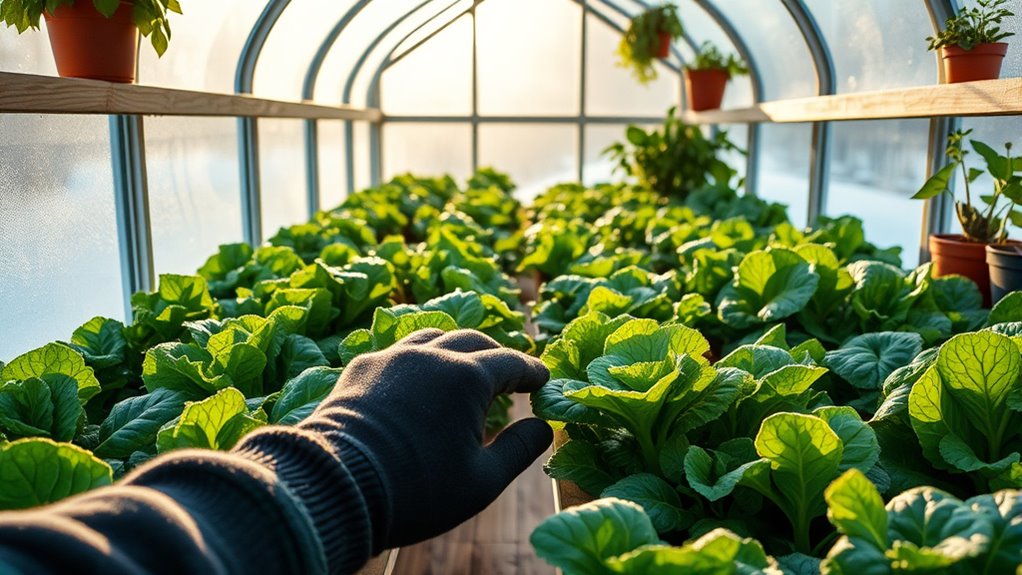
Choosing the right crops for winter greenhouse gardening means focusing on varieties that can withstand cold temperatures or thrive indoors. Your plant selection should prioritize crops with high crop hardiness, ensuring they survive low temperatures and limited sunlight. Hardy vegetables like kale, spinach, and Swiss chard are excellent options because they tolerate the cold and can grow with minimal fuss. Root vegetables such as carrots and radishes also perform well indoors or in unheated areas. For indoor-friendly crops, consider herbs like mint, parsley, and chives, which adapt easily to indoor conditions. Additionally, selecting plants with plant hardiness can maximize your success during the colder months. Incorporating seasonal adaptability into your selection process will help you maintain a productive and vibrant winter garden. To further enhance your gardening success, understanding climate resilience can help you choose crops best suited to your specific environment, especially considering how indoor and outdoor conditions influence plant growth.
Managing Light and Ventilation During Winter

To keep your greenhouse thriving in winter, you need to optimize daylight exposure by positioning your plants where they receive the most sunlight. At the same time, balancing temperature and airflow helps prevent issues like frost or mold. Adjusting your ventilation carefully guarantees your plants stay healthy and productive all season long. Ensuring proper air circulation can also help reduce humidity levels that promote mold growth. Additionally, maintaining good airflow is essential for preventing unwanted pests and diseases that can thrive in damp conditions.
Optimizing Daylight Exposure
Maximizing daylight exposure during winter requires careful management of light and ventilation in your greenhouse. To boost sunlight, consider strategic pruning techniques to open up plant canopies, allowing more light to reach lower leaves. Additionally, crop rotation helps maintain healthy plants that efficiently utilize available daylight. Ensure your greenhouse is positioned to capture maximum sun exposure and use reflective surfaces to bounce light into shaded areas. Keep vents and windows clean to prevent dust buildup that blocks sunlight. Use shading materials during cloudy days to prevent overheating. Incorporating sound therapy techniques can also promote a calm environment that supports healthy plant growth during darker months. Regularly monitoring light levels ensures your plants receive adequate illumination to thrive throughout the season. Employing natural light management strategies can further optimize your greenhouse’s efficiency and promote vigorous plant growth in winter. Utilizing climate control systems, such as heaters and fans, can help maintain optimal temperature and humidity levels, further enhancing light utilization and plant health during colder months.
Balancing Temperature and Airflow
Maintaining the right balance between temperature and airflow is key to a healthy winter greenhouse. Proper airflow regulation prevents excess humidity, which can lead to mold and fungal diseases. Use vents and fans to ensure fresh air circulates without creating drafts that chill your plants. During cold spells, close vents to retain heat, but open them during milder days to promote humidity control and prevent stagnation. Monitoring temperature and humidity levels helps you adjust airflow efficiently. Incorporating air filtration techniques can also improve circulation and maintain optimal conditions. Proper ventilation management ensures that your plants receive sufficient fresh air while minimizing the risk of disease and stress caused by improper airflow. Avoid over-ventilating, which can cause temperature fluctuations, or under-ventilating, which can lead to excess moisture. Incorporating natural airflow techniques can also improve circulation and maintain optimal conditions. Consistent airflow not only stabilizes temperature but also promotes healthy plant growth, reduces disease risks, and optimizes overall greenhouse conditions during winter.
Soil Preparation and Fertilization for Year-Round Growth

To guarantee your greenhouse produces healthy plants year-round, start by testing your soil to identify nutrient deficiencies.
Use the right fertilizers—whether organic or synthetic—to enrich your soil effectively. Understanding the benefits of each method helps you choose the best approach for consistent, vibrant growth.
Soil Testing and Amendments
Have you tested your soil lately? Knowing your soil’s condition is essential for successful winter greenhouse gardening. Start by conducting a soil test to determine its pH and nutrient levels.
If your pH is off, you’ll need to adjust it with soil pH adjustments to create ideal growing conditions. Incorporate composting techniques to enrich your soil naturally, adding organic matter that improves structure and fertility.
Composting also helps balance soil nutrients, reducing the need for synthetic fertilizers. Once you know your soil’s deficiencies, you can make targeted amendments to ensure healthy plant growth during colder months.
Regular testing and proper adjustments set a strong foundation for year-round cultivation, helping you extend your growing season with confidence.
Nutrient-Rich Fertilizer Use
Using nutrient-rich fertilizers is essential for ensuring your greenhouse plants receive the essential elements they need to thrive year-round. To maintain healthy growth, develop a consistent fertilizer schedule tailored to your plants’ needs, adjusting as they progress.
Incorporate composting techniques to create rich, organic matter that naturally supplies nutrients and improves soil structure. Regularly top up with compost or organic fertilizers to sustain soil fertility.
Keep these tips in mind:
- Follow a specific fertilizer schedule based on plant type and growth stage
- Use composted materials to enhance soil nutrient content naturally
- Adjust feeding frequency during different seasons for ideal results
Organic vs. Synthetic Methods
Choosing between organic and synthetic methods for soil preparation and fertilization impacts your greenhouse’s productivity and sustainability. Organic methods focus on using natural soil amendments like compost, manure, and biochar, which improve soil health and promote natural pest control. These approaches foster a balanced ecosystem, reducing reliance on chemicals and supporting year-round growth.
Synthetic fertilizers, on the other hand, provide quick nutrient boosts but may harm soil structure and decrease long-term fertility if overused. If you prefer a more eco-friendly, sustainable setup, organic methods align well with your goals. They also make it easier to create a resilient environment that naturally deters pests while maintaining nutrient levels.
Ultimately, choosing organic soil amendments helps you grow healthier plants while protecting your greenhouse’s long-term robustness.
Tips for Maintaining Pest Control and Disease Prevention
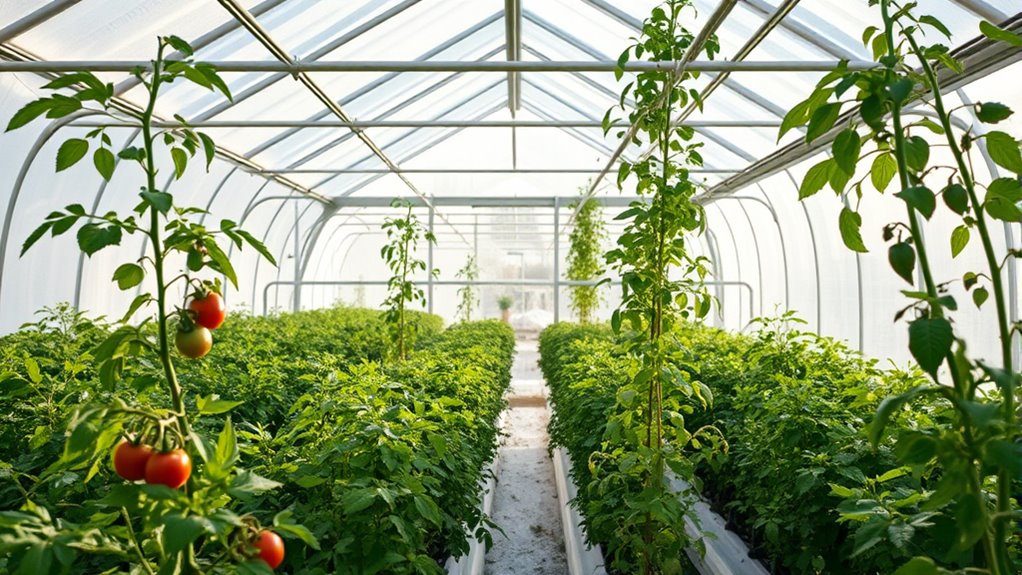
Maintaining pest control and preventing diseases in your winter greenhouse requires proactive measures and vigilant monitoring. Start by selecting pest resistant varieties and disease resistant crops to reduce vulnerabilities.
Keep your greenhouse clean and free of debris, which can harbor pests and pathogens. Use physical barriers like row covers to prevent insect access.
Regularly inspect plants for early signs of trouble, and remove affected leaves or plants immediately. Maintain proper ventilation to reduce humidity, which discourages mold and fungal growth.
Consider introducing beneficial insects or natural predators to control pest populations naturally. By staying alert and implementing these strategies, you’ll create a healthier environment that minimizes the need for chemical interventions and keeps your winter crops thriving.
Frequently Asked Questions
How Can I Automate Watering in My Winter Greenhouse?
To automate watering in your winter greenhouse, consider using automatic timers combined with drip irrigation systems. You can set the timers to deliver water at specific times, ensuring your plants stay hydrated without daily attention.
Drip irrigation provides consistent moisture directly to the roots, preventing overwatering or underwatering. This setup saves you time, reduces water waste, and helps maintain healthy plants throughout the winter months.
What Are Cost-Effective Ways to Finance Greenhouse Setup?
Did you know that nearly 60% of new homeowners use budget planning to fund major projects?
When financing your greenhouse setup, focus on affordable funding sources like personal savings, small business loans, or grants.
Consider creating a detailed budget plan to identify costs and prioritize expenses.
Exploring these options helps you reduce upfront costs and guarantees your investment aligns with your financial situation, making your greenhouse dreams more achievable.
How Do I Prevent Condensation and Mold Buildup?
To prevent condensation and mold buildup, you should focus on effective ventilation strategies. Make sure to regularly circulate air using exhaust fans or vents, especially during warm, humid days.
Keep humidity levels in check with dehumidifiers if needed. Proper airflow helps mold prevention by reducing excess moisture.
Additionally, wipe down surfaces and monitor for damp spots. Consistent ventilation and mold prevention practices keep your greenhouse environment healthy and mold-free.
Can I Grow Tropical Plants in a Winter Greenhouse?
Imagine you’re growing a vibrant hibiscus in your winter greenhouse. Yes, you can cultivate tropical plant varieties during colder months with proper greenhouse climate control.
Ensuring consistent warmth, humidity, and light mimics their natural environment, so they thrive. Using heaters and humidifiers, you create a summer-like atmosphere indoors.
This way, your tropical plants flourish, and you enjoy lush greenery all year round, despite outside winter conditions.
What Safety Precautions Are Needed for Heating Systems?
When setting up your heating system, prioritize heater safety by choosing reliable, certified units. Always install smoke and carbon monoxide detectors nearby to prevent fire and gas hazards.
Keep heaters away from flammable materials and ensure proper ventilation. Regularly inspect and maintain your heater to avoid malfunctions.
Conclusion
By choosing the right greenhouse and optimizing insulation, heating, and lighting, you can extend your growing season well into winter. Did you know that with proper planning, some gardeners report up to 50% more harvests during colder months? Keep your crops healthy with pest control and soil care, and you’ll enjoy fresh produce year-round. Winter gardening isn’t just possible—it’s rewarding, transforming your space into a vibrant, productive oasis even when temperatures drop.
